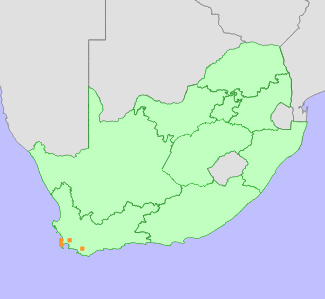|
Scientific Name | Aspalathus macrantha Harv. |
Higher Classification | Dicotyledons |
Family | FABACEAE |
Common Names | Largeflower Capegorse (e) |
National Status |
Status and Criteria | Endangered B1ab(iii,v)+2ab(iii,v) |
Assessment Date | 2021/04/05 |
Assessor(s) | D. Raimondo |
Justification | A species endemic to granite and shale bands of the mountains of the South Western Cape, South Africa. The historic extent of occurrence (EOO) was 463 km², but as a result of loss of subpopulations to urban development, and conversion of habitat to vineyards and forest plantations, it now has an EOO of 101 km² and an area of occupancy (AOO) of 16 km². The population is known only from three locations and continues to decline due to ongoing habitat loss and degradation to invasive alien plant infestations and inappropriate fire management. It therefore qualifies for listing as Endangered under criterion B. |
Distribution |
Endemism | South African endemic |
Provincial distribution | Western Cape |
Range | This species is found in the Cape Peninsula and Hottentots Holland Mountains. |
Habitat and Ecology |
Major system | Terrestrial |
Major habitats | Cape Winelands Shale Fynbos, Peninsula Shale Fynbos, Peninsula Granite Fynbos, Boland Granite Fynbos |
Description | It grows in granite and shale fynbos on lower slopes, 200-350 m. |
Threats |
| Less than 25% of this species' habitat remains intact, and it is poorly protected. On the Cape Peninsula, the majority of granite and shale fynbos on lower mountain slopes has been lost to urban expansion, vineyards and timber plantations, and loss continues. This species requires fire for regeneration, but fires are often suppressed close to plantations and private properties. Other sites such as Devil's Peak burns far too frequently for reseeding species to reach maturity, this species has been lost from this area as a result. In the Jonkershoek Valley, this species' habitat has been extensively converted to timber plantations, and remaining areas are severely degraded due to alien plant invasions. A small area of intact habitat remains within the Hottentots Holland Nature Reserve. |
Population |
Dahlgren (1988) noted that this species was becoming rare in the Wynberg area of the Cape Peninsula, which is the only place he was able to locate the species, and where it is now quite likely locally extinct, as no undisturbed vegetation remains. In spite of the Cape Peninsula being one of South Africa's botanically best explored areas, records of this species are scarce, and most are older than 50 years. It has been recorded at three locations over the past 15 years, at Jonkershoek Nature Reserve on the Hottentot Hollands Mountains; Vlakkenberg and the Upper Tokai section of the Table Mountain National Park on the Cape Peninsula. It requires fire for regeneration, and may be particularly rare in senescent vegetation.
|
Population trend | Decreasing |
Assessment History |
Taxon assessed |
Status and Criteria |
Citation/Red List version | | Aspalathus macrantha Harv. | EN B1ab(ii,iii,iv)+2ab(ii,iii,iv) | Raimondo et al. (2009) | | Aspalathus macrantha Harv. | Indeterminate | Hilton-Taylor (1996) | | Aspalathus macrantha Harv. | Uncertain | Hall et al. (1980) | |
Bibliography |
Dahlgren, R. 1965. Revision of the genus Aspalathus. II. The species with ericoid and pinoid leaflets. 4. The Aspalathus ericifolia, parviflora, calcarata, desertorum, macrantha, pinea, rostrata, filicaulis, laricifolia and longifolia groups. Opera Botanica 10(1):1-231.
Dahlgren, R. 1988. Crotalarieae (Aspalathus). In: O.A. Leistner (ed). Flora of southern Africa 16 Fabaceae, Part 3 Papilionoideae, Fascicle 6:1-430. National Botanical Institute, Pretoria.
Goldblatt, P. and Manning, J.C. 2000. Cape Plants: A conspectus of the Cape Flora of South Africa. Strelitzia 9. National Botanical Institute, Cape Town.
Hall, A.V., De Winter, M., De Winter, B. and Van Oosterhout, S.A.M. 1980. Threatened plants of southern Africa. South African National Scienctific Programmes Report 45. CSIR, Pretoria.
Hilton-Taylor, C. 1996. Red data list of southern African plants. Strelitzia 4. South African National Botanical Institute, Pretoria.
Raimondo, D., von Staden, L., Foden, W., Victor, J.E., Helme, N.A., Turner, R.C., Kamundi, D.A. and Manyama, P.A. 2009. Red List of South African Plants. Strelitzia 25. South African National Biodiversity Institute, Pretoria.
|
Citation |
| Raimondo, D. 2021. Aspalathus macrantha Harv. National Assessment: Red List of South African Plants version 2024.1. Accessed on 2025/10/26 |
 Comment on this assessment
Comment on this assessment

